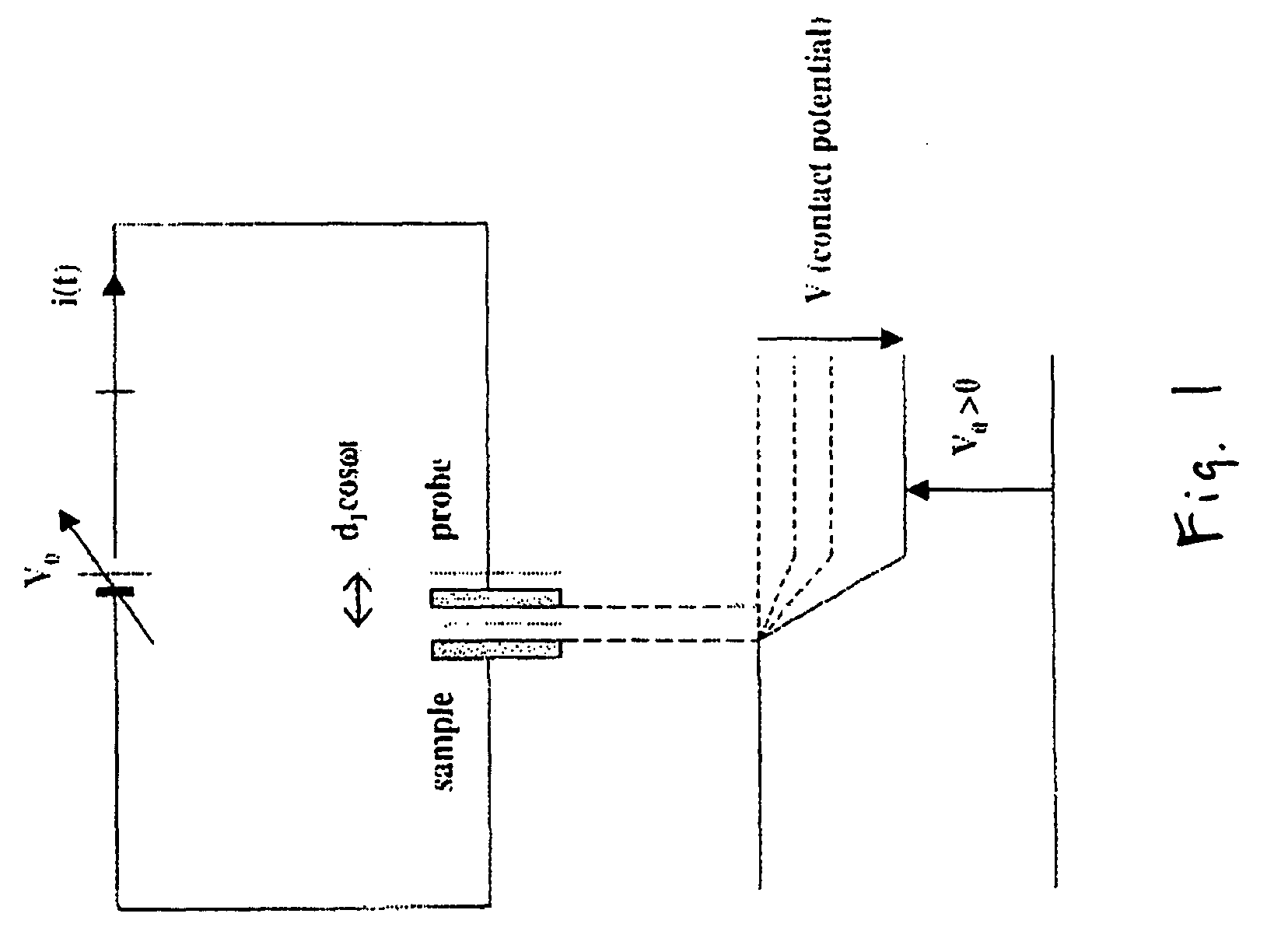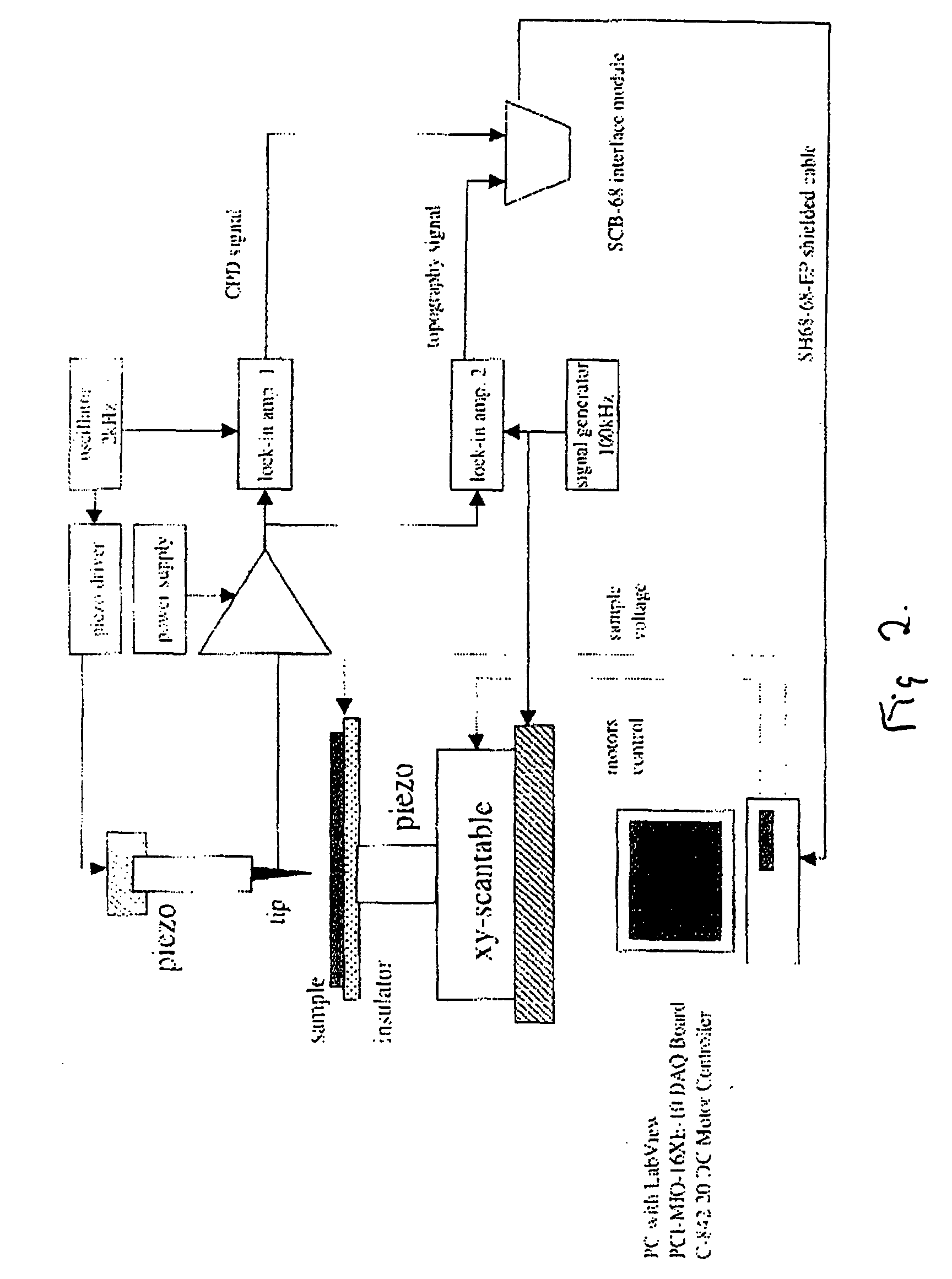Scanning kelvinmicroprobe system and process for biomolecule microassay
a microprobe and scanning kelvin technology, applied in the field of biomolecule microassay system and process, can solve the problems of inability to direct measurement with a voltmeter included in the circuit, high electric field, and high beams of electrons or photons,
- Summary
- Abstract
- Description
- Claims
- Application Information
AI Technical Summary
Benefits of technology
Problems solved by technology
Method used
Image
Examples
example 1
[0068] Surface Measurement and Analysis of Silicon Wafer by SKM
[0069] This experiment was conducted to obtain images that can serve as a control for any changes produced by subsequent surface chemical treatments. FIGS. 3A and 3B show the tandem topographical and CPD images obtained at 20 .mu.m spatial resolution for the bare silicon wafer, respectively. The wafer was used for the immobilizing nucleic acids. With respect to the topographical image, the picture was recorded viewing from the y-axis in order to isolate an obvious fissure of depth about 800 nm (width at half-depth is 100 .mu.m). Aside from this structure, which is likely related to scratching connected to a polishing protocol, the surface height variability is of the order of 300 nm (0.15 V). The image also exhibits fairly uniform "peaks" with a half height dimension of about 100 nm. These characteristics are expected from a substrate surface that is considered to be optically flat. The CPD image shows a quite narrow ran...
example 2
[0070] Surface Measurement and Analysis of Oligonucleotides Attached to a Silicon Substrate
[0071] The immobilization of nucleic acids on biosensors and gene chips using TTU represents a new research area. The attachment of oligonucleotides to a silicon substrate was tested by employing the capabilities of the new SKM instrument.
[0072] With respect to the use of Kelvin probe measurements to distinguish oligonucleotide and DNA duplex formation, the 25-mer probe, F.sub.1, with BMBS linker in place, attaches to the de-protected TTU monolayer on the Si wafer through formation of a disulfide bond. Using this approach, the probe is disposed closer to the substrate surface at the 5'-end, whereas the 3'-terminus faces away from the interface. Experience has shown that the surface packing density attainable by this attachment protocol is of the order of 20 pmol cm.sup.-2. This value implies that the surface density of attached nucleic acid is in the region of 1 molecule per 10 square nanomete...
example 3
[0073] Surface Measurement and Analysis of Duplex Formation Between Oligonucleotides
[0074] FIG. 5 shows the CPD image of the same surface for F.sub.2 hybridized to F.sub.1. The overall surface variability and features are much the same as for the single strand 25-mer attached to the substrate, but the CPD value has shifted upward by over 200 mV. This result clearly indicates that detection of duplex formation by the SKM is feasible. Since the attainable resolution in relative CPD value is 1 mV, this result implies that high discrimination of the level of duplex formation connected to mismatches is feasible.
PUM
| Property | Measurement | Unit |
|---|---|---|
| Radius | aaaaa | aaaaa |
| Radius | aaaaa | aaaaa |
| Frequency | aaaaa | aaaaa |
Abstract
Description
Claims
Application Information
 Login to View More
Login to View More - R&D
- Intellectual Property
- Life Sciences
- Materials
- Tech Scout
- Unparalleled Data Quality
- Higher Quality Content
- 60% Fewer Hallucinations
Browse by: Latest US Patents, China's latest patents, Technical Efficacy Thesaurus, Application Domain, Technology Topic, Popular Technical Reports.
© 2025 PatSnap. All rights reserved.Legal|Privacy policy|Modern Slavery Act Transparency Statement|Sitemap|About US| Contact US: help@patsnap.com



